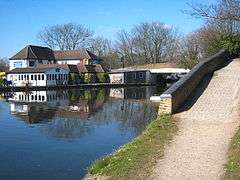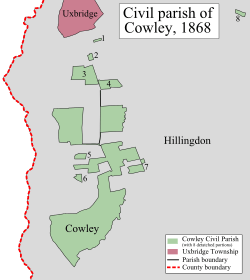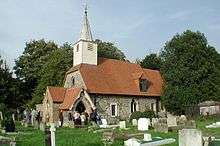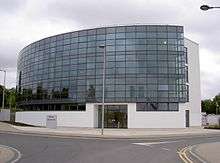Cowley, London
Cowley /ˈkaʊli/ is a village contiguous with the town of Uxbridge in the London Borough of Hillingdon. A largely suburban village with 16 listed buildings, Cowley is 15.4 miles (24.8 km) west of Charing Cross, bordered to the west by Uxbridge Moor in the Green Belt and the River Colne, forming the border with Buckinghamshire.[n 1] Cowley lies on a ridge 28 to 45 m (92 to 148 ft) above mean sea level.
| Cowley | |
|---|---|
_-_geograph.org.uk_-_801322.jpg) Cowley Peachey | |
 The Water's Edge restaurant, Cowley | |
 Cowley Location within Greater London | |
| Population | 8,776 [1] |
| OS grid reference | TQ055825 |
| • Charing Cross | 15.4 mi (24.8 km) E |
| London borough | |
| Ceremonial county | Greater London |
| Region | |
| Country | England |
| Sovereign state | United Kingdom |
| Post town | UXBRIDGE |
| Postcode district | UB8 |
| Dialling code | 01895 |
| Police | Metropolitan |
| Fire | London |
| Ambulance | London |
| UK Parliament | |
| London Assembly | |
History
Medieval Period
St. Laurence Church was in recorded as in the parish of Cowley in the 1086 Domesday Book along with the parish land owned by Westminster Abbey, valued as worth to its lord two pounds per year in 1066 and at one pound ten shillings in 1086. Its independent male householders were two villagers[n 2], one cottage-owner[n 3] with one cultivated ploughland for one lord's plough team. Lord's lands (also referred to as a manorial park) took up 1.5 ploughs of land, and meadow land half a plough. The woodland was worth forty pigs (per year) and a mill was worth for five shillings per year.[2]
A lay franchise (jurisdiction) of the church was held in 1293 by Lucy Peachey, whose name is reflected in several of the roads and by the local government ward of Cowley Peachey.[3]
Cowley was surrounded by Hillingdon parish, of which the town of Uxbridge itself and Uxbridge Moor, which separated Cowley from Buckinghamshire on the west, formed part. Part of the Moor is now the M25 motorway.[4] Within the triangle formed where the River Pinn and Fray's River meet, Cowley parish was so intermixed with Hillingdon that parts of it were entirely detached from the rest, while other parts, some detached, lay farther east across the Pinn. For this reason most of the general history of the parish has to be dissected from that of Hillingdon. These complex parish borders were those of just one manor carved out before the Norman conquest from Hillingdon.[5] While Hillingdon parish administered to many areas now in Cowley, most of these were in one manor within Hillingdon whose name is preserved by few places in maps, Colham.[5]
In the west, along the main road between Uxbridge and West Drayton, and mostly to the north of the Iver Lane turning, lay the village formerly known as Cowley Street, mostly in Cowley parish. This hamlet and the church hamlet formed the main areas of settlement within the parish, though there were a few houses elsewhere, including some at what is now called Cowley Peachey, the southern part of Cowley. This name, however, is of recent origin as applied to the hamlet as its older name of 'Three Households' or 'Three Houses' indicates – Cowley Peachey was not a settlement in itself: part in any case lay outside the parish bounds.[5]
Post Reformation and Boundaries

Before 1882, when the first important changes were made in its boundaries, the parish of Cowley spanned 300 acres (120 ha) extremely irregularly shaped but mostly south of Uxbridge, between Frays River (the county boundary, part of the braided Colne) on the west and the River Pinn, which runs into it on the east.[5] A small piece (2 acres (0.81 ha)) of glebe land belonged to Cowley church on the other side of Hillingdon by Long Lane.[5]
In 1796 Cowley Field was inclosed, with the statutory object of consolidating the parishes of Hillingdon and Cowley. As a result, Cowley received several blocks of land, of which the largest were connected to the part of the parish by the church and to the part at Cowley Street by roads which the Commissioners decreed were to be repaired by Cowley parish and which therefore became part of it. Four parts of the field north of the Greenway were also assigned to Cowley but remained detached (nos. 1-4 on the map), and so did two others farther south by the High Street and by Maygoods Lane (nos. 5-6). Nomansland (no. 7), across the Pinn, also remained cut off from the rest of the parish, while the little field of glebe nearly 2 miles away in Long Lane (no. 8) was unaffected by the award.[5]
In 1547 the parish contained 36 'houseling' people, in 1719 there were 109 inhabitants, and in 1801 the population was 214. The small cluster of homes at the village centre and dispersal of parishioners based on the old, medieval scope of the manor's lands meant a low sense of community and identity especially for outlying owners. Furthermore, some fields and orchards of Cowley had become additions to plots falling in Hillingdon so tithes would be the only ties left if plot holders lived in houses on Hillingdon land. The manorial court for many centuries made regulations and byelaws about fencing and grazing of the open fields, pasture meadows, and commons, particularly as to the stinting of animals.[5]
Post Industrial Revolution
During the later 19th century increasing amounts of land were given over to market- and nursery-gardens, and to brickworks. About 1800 the stretch of the Grand Junction Canal through Cowley was opened, and packet boats ran for a while in 1801 and occasionally in the next few years between Uxbridge and London. The Packet Boat Inn at Cowley Peachey, licensed in 1804, commemorates the period, and the small group of buildings had appeared around two docks there by 1825.[5]
The Uxbridge branch of the Great Western Railway was opened in 1856 and ran through Cowley, but there was no station here until 1904, and despite the spread of building from Uxbridge in the north, the beginnings of industry at Cowley Peachey, and the three large mills just outside the western boundary of the parish, Cowley remained an almost entirely rural village until after World War I In 1891, just before the parish was enlarged, the population was 322. In 1901, after the enlargement, it was 869, and this had only risen to 1,170 by 1931. During the 1930s there was a good deal of building, partly by Uxbridge council, and the population of the same area was 3,687 in 1951. Until 1965 a great many more houses were built, bringing the total provided by the council to nearly 1,000 in 1959, so that much of the area east of the main road and south of Station Road has been covered, though allotments remain between Hillingdon and Cowley.[4] The diversion of Peachey Lane in 1938 and the blocking of Maygoods Lane about 1953 have destroyed the old road plan of this part of the parish.[5]
Cowley became part of the urban district of Uxbridge in 1929 and part of Uxbridge civil parish in 1937.[5]
Geography
.jpg)
Cowley lies on a southwest-sloping ridge 28 to 45 m (92 to 148 ft) above mean sea level[4] and is a village[n 5] contiguous with Uxbridge to the north, in the west of the London Borough of Hillingdon — a largely suburban development, it is 15.4 miles (24.8 km) west of Charing Cross, bordered to the west by the Metropolitan Green Belt, the River Colne and Buckinghamshire. Between the boundaries marked by the Pinn and Colne the soil is traditionally called (fertile) brick-earth which has medium permeability whereas east of the Pinn covering most of London is London clay and gravel, a mixture of good and poor drainage. On more descriptive modern analysis the soil is "slowly permeable seasonally wet acid loamy and clayey soil", with non-permeable loamy soil marking the lowest part.[6]
Two conservation areas are in the village: Cowley Church (St. Laurence), designated in 1988 and Cowley Lock, designated in 1975, which includes all of Old Mill Lane, Cowley Lake, wet woodland, Little Britain[n 6] and Cowley bridges.[7]
Little Britain Lake
Little Britain Lake (51°31′10″N 0°29′23″W) in the west of Cowley extends for about 450 metres between the Colne and a channel of it known as Frays River.[4] The lake, which is in the Colne Valley Regional Park conservation area, is roughly the shape of the British Isles and has small islands. It is noted for less common water birds, such as gadwall and great crested grebe, and for more common species including mute swan and grey heron.[8]
Landmarks


A number of older buildings survive, forming in Cowley all but one of the 15 architecturally listed buildings, the other being the main lecture building of Brunel University.
Cowley House, and the Manor Farm are the most architecturally and historically significant.[5] In the High Street, Old Vine Cottage, The Crown, and Maygood's Farm date from before 1700, and there are several detached 18th-century houses there, some of which may incorporate earlier work. At Cowley Peachey are two timber-framed houses: the Old Cottage probably dates from the 15th or early 16th century and is a three-bay house of which the central bay was originally an open hall. At some later date the hall was divided into two storeys and a brick chimney was inserted. The Shovel in Iver Lane is also Grade II listed.
Church
St Laurence Church is listed higher than all of the other buildings in Cowley architecturally, at Grade II*, this building was in existence by the 12th century, stands near the Pinn on the eastern side of the manor: there is no evidence of a proper settlement of any size here, though there were probably always one or two buildings beside the Church.[5]
Transport
Nearest tube station
- Uxbridge (Metropolitan and Piccadilly lines) 0.6 miles (0.97 km) north of the northern boundary of Cowley[10]
Nearest railway stations
- West Drayton 0.5 miles (0.80 km) south of the Cowley Peachey border[10]
- Iver 1.4 miles (2.3 km) west of Packet Boat Lane in Little Britain, Cowley[10]
Uxbridge branch railway line was a two-track railway operating from 1836 to 10 September 1962 between West Drayton in Yiewsley on the Great Western Main Line and Uxbridge, with an intermediate station at Cowley. Station Road in Cowley has bridges where the tracks once were.
Notable people
- Roger Williams (1603-1683), important early proponent of religious freedom and separation of church and state, was born in Cowley
- Barton Booth (1681-1733), one of the most famous actors of the early 18th century, lived and is buried in Cowley
- John Rich (1692-1761), the "father of English pantomime", lived in Cowley
- William Dodd (1729-1777), writer and clergyman, once royal chaplain, was buried in Cowley after being hanged at Tyburn
- Botanist John Lightfoot (1735-1788) lived in Uxbridge from 1767 and is buried here where he was curate from 1768 to 1786.[5]
- England footballer Jim Taylor (1917-2001), born in Cowley
- Racing driver Robin Widdows (1942-), born in Cowley
- Natasha Baker (born 1989), Para-equestrian and double gold medallist at the 2012 Summer Paralympics, lives in Cowley. The main postbox in Uxbridge town centre was painted gold by Royal Mail in her honour, as was done for all Team GB and Paralympics GB gold medallists.[11]
Notes and references
- Notes
- References
- 2001 Census — MLSOA Hillingdon 22 which excludes a small portion of the ecclesiastical parish only
- Cowley in the Domesday Book. Retrieved 21 October 2017.
- Susan Reynolds (Editor) (1962). "The hundred of Elthorne". A History of the County of Middlesex: Volume 3. Institute of Historical Research. Retrieved 27 November 2012.CS1 maint: extra text: authors list (link)
- "Ordnance survey website". Archived from the original on 29 October 2013. Retrieved 18 April 2006.
- Susan Reynolds (Editor) (1962). "Cowley: Introduction". A History of the County of Middlesex: Volume 3: Shepperton, Staines, Stanwell, Sunbury, Teddington, Heston and Isleworth, Twickenham, Cowley, Cranford, West Drayton, Greenford, Hanwell, Harefield and Harlington. Institute of Historical Research. Retrieved 27 November 2012.CS1 maint: extra text: authors list (link)
- Cranfield University National Soil Resources Institute
- "Conservation areas in the London Borough of Hillingdon". Archived from the original on 6 August 2013. Retrieved 27 November 2012.
- "Colne Valley Park". Colne Valley Regional Park. Retrieved 4 January 2010.
- The Church of England - Map of St Lawrence's Ecclesiastical Parish
- Grid reference Finder measurement tools
- "Hillingdon Paralympic champ gets gold!". London Borough of Hillingdon. 3 September 2012. Archived from the original on 24 September 2015. Retrieved 4 December 2012.
